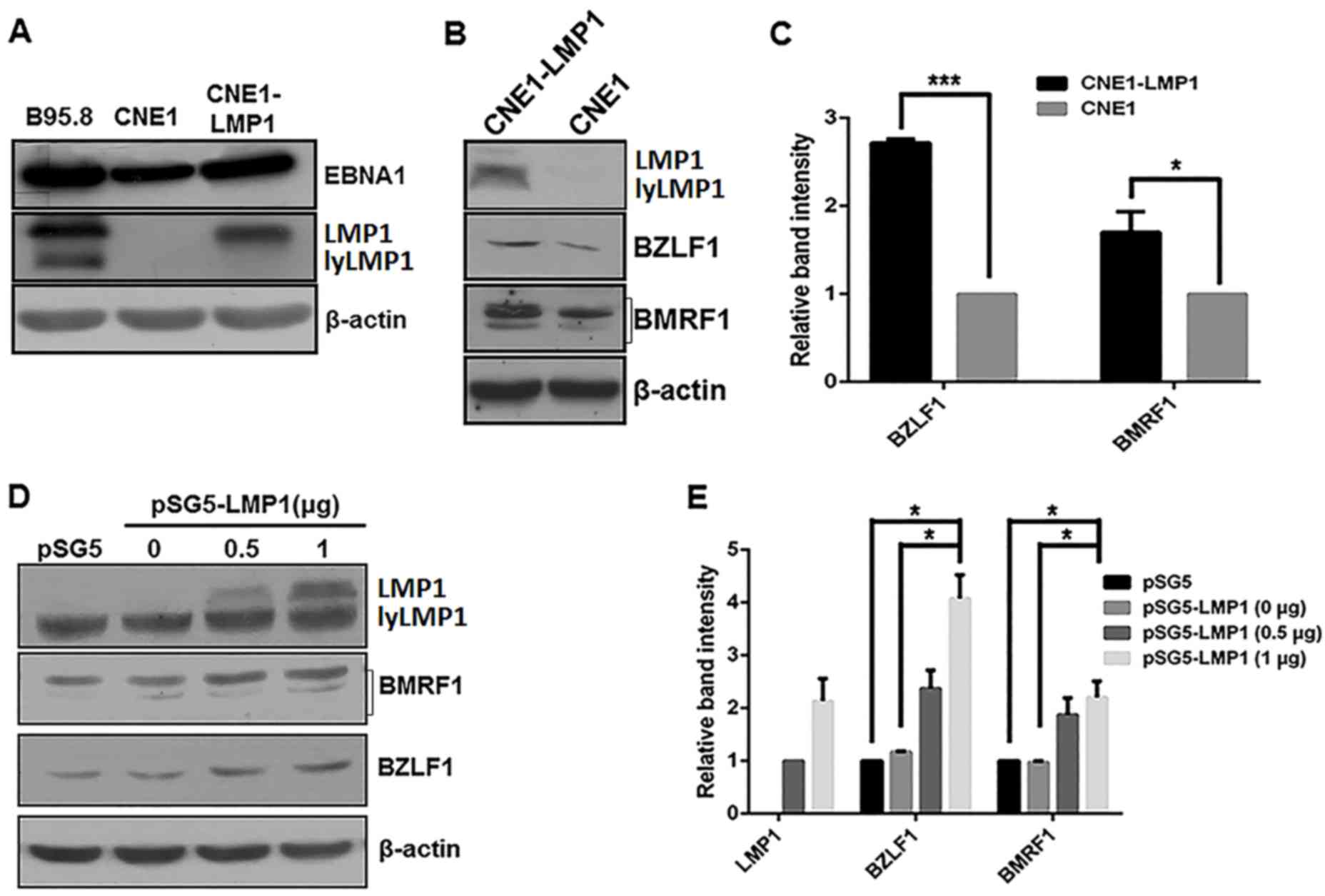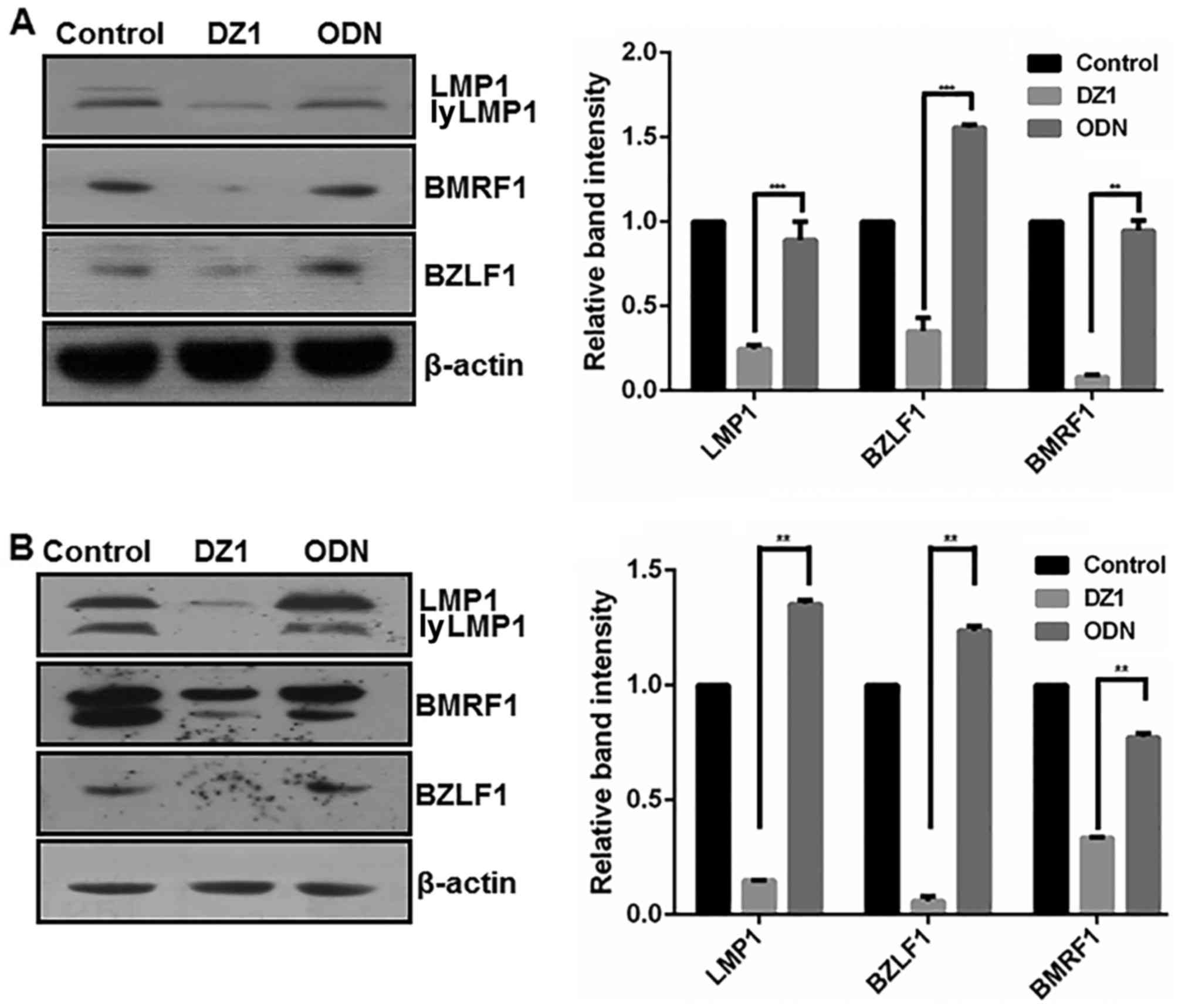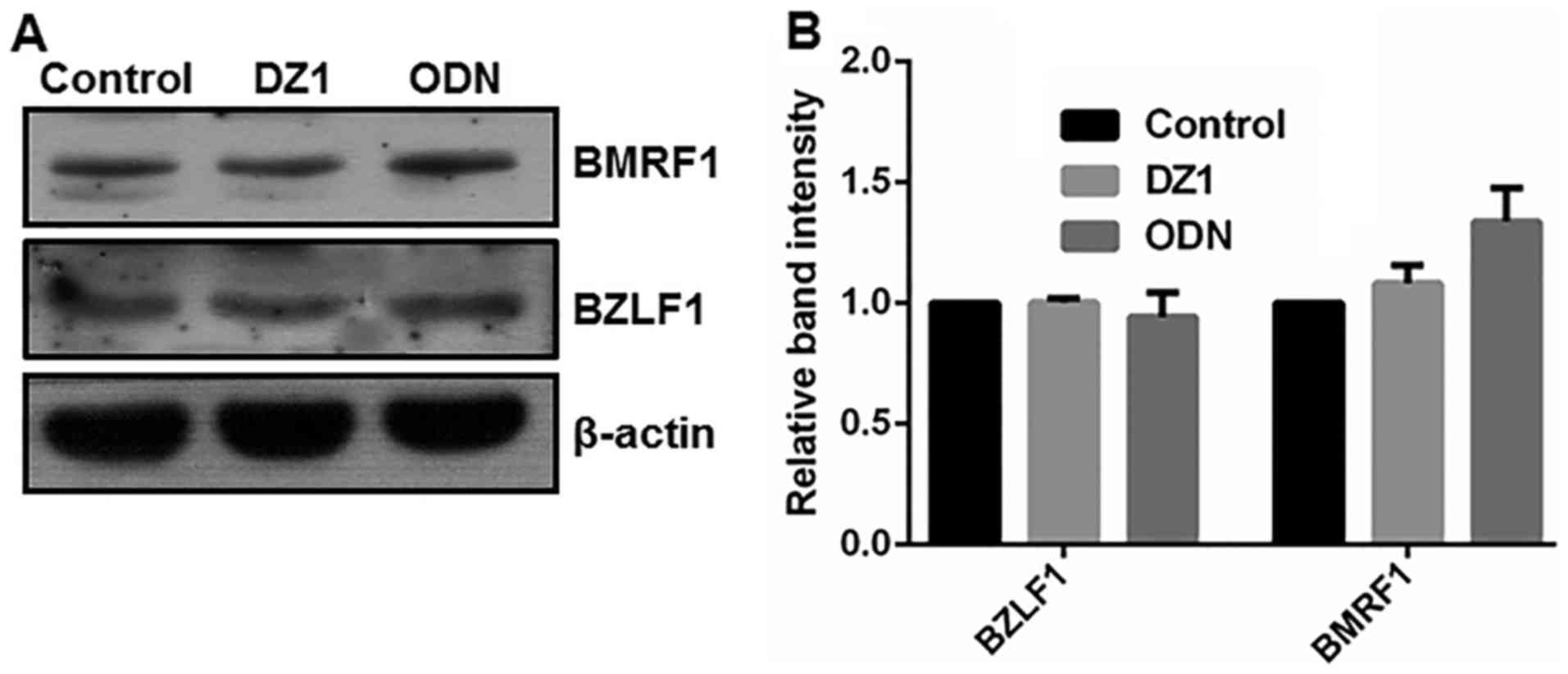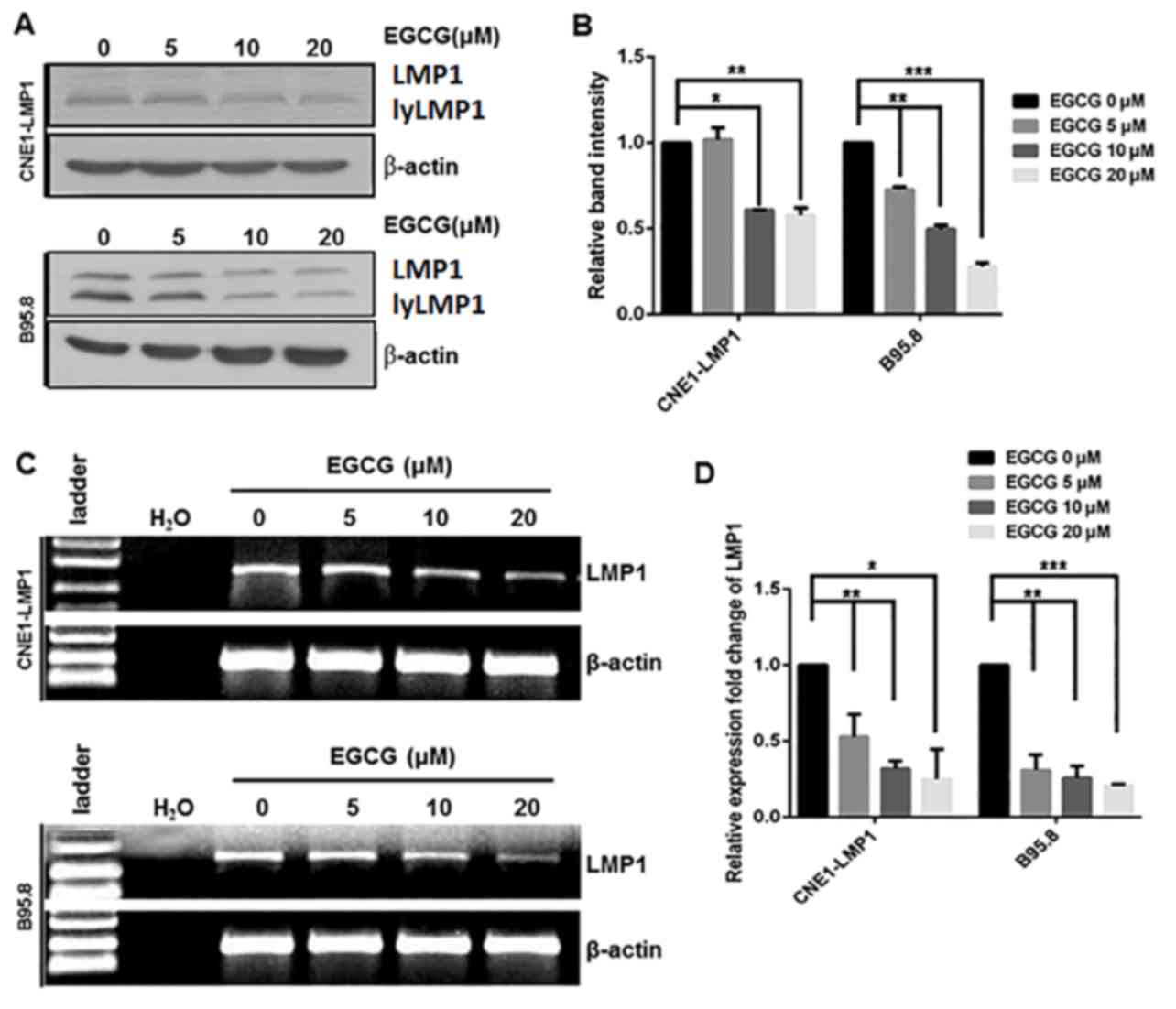|
1
|
Cohen JI, Fauci AS, Varmus H and Nabel GJ:
Epstein-Barr virus: An important vaccine target for cancer
prevention. Sci Transl Med. 3:107fs72011. View Article : Google Scholar : PubMed/NCBI
|
|
2
|
Young LS and Murray PG: Epstein-Barr virus
and oncogenesis: From latent genes to tumours. Oncogene.
22:5108–5121. 2003. View Article : Google Scholar : PubMed/NCBI
|
|
3
|
Young LS and Rickinson AB: Epstein-Barr
virus: 40 years on. Nat Rev Cancer. 4:757–768. 2004. View Article : Google Scholar : PubMed/NCBI
|
|
4
|
Sugawara Y, Makuuchi M and Takada K:
Detection of Epstein-Barr virus DNA in hepatocellular carcinoma
tissues from hepatitis C-positive patients. Scand J Gastroenterol.
35:981–984. 2000. View Article : Google Scholar : PubMed/NCBI
|
|
5
|
Kutok JL and Wang F: Spectrum of
Epstein-Barr virus-associated diseases. Annu Rev Pathol. 1:375–404.
2006. View Article : Google Scholar : PubMed/NCBI
|
|
6
|
Hammerschmidt W and Sugden B: Replication
of Epstein-Barr viral DNA. Cold Spring Harb Perspect Biol.
5:a0130292013. View Article : Google Scholar : PubMed/NCBI
|
|
7
|
Murata T: Regulation of Epstein-Barr virus
reactivation from latency. Microbiol Immunol. 58:307–317. 2014.
View Article : Google Scholar : PubMed/NCBI
|
|
8
|
Murata T and Tsurumi T: Switching of EBV
cycles between latent and lytic states. Rev Med Virol. 24:142–153.
2014. View
Article : Google Scholar : PubMed/NCBI
|
|
9
|
Lei KI, Chan LY, Chan WY, Johnson PJ and
Lo YM: Quantitative analysis of circulating cell-free Epstein-Barr
virus (EBV) DNA levels in patients with EBV-associated lymphoid
malignancies. Br J Haematol. 111:239–246. 2000. View Article : Google Scholar : PubMed/NCBI
|
|
10
|
Lo YM: Quantitative analysis of
Epstein-Barr virus DNA in plasma and serum: Applications to tumor
detection and monitoring. Ann N Y Acad Sci. 945:68–72. 2001.
View Article : Google Scholar : PubMed/NCBI
|
|
11
|
Geser A, de Thé G, Lenoir G, Day NE and
Williams EH: Final case reporting from the Ugandan prospective
study of the relationship between EBV and Burkitt's lymphoma. Int J
Cancer. 29:397–400. 1982. View Article : Google Scholar : PubMed/NCBI
|
|
12
|
Mueller N, Evans A, Harris NL, Comstock
GW, Jellum E, Magnus K, Orentreich N, Polk BF and Vogelman J:
Hodgkin's disease and Epstein-Barr virus. Altered antibody pattern
before diagnosis. N Engl J Med. 320:689–695. 1989. View Article : Google Scholar : PubMed/NCBI
|
|
13
|
Boos H, Berger R, Kuklik-Roos C, Iftner T
and Mueller-Lantzsch N: Enhancement of Epstein-Barr virus membrane
protein (LMP) expression by serum, TPA, or n-butyrate in latently
infected Raji cells. Virology. 159:161–165. 1987. View Article : Google Scholar : PubMed/NCBI
|
|
14
|
Ramos S: Cancer chemoprevention and
chemotherapy: Dietary polyphenols and signalling pathways. Mol Nutr
Food Res. 52:507–526. 2008. View Article : Google Scholar : PubMed/NCBI
|
|
15
|
Yang CS and Wang H: Cancer therapy
combination: Green tea and a phosphodiesterase 5 inhibitor? J Clin
Invest. 123:556–558. 2013.PubMed/NCBI
|
|
16
|
Zhao Y, Wang H, Zhao XR, Luo FJ, Tang M
and Cao Y: Epigallocatechin-3-gallate interferes with EBV-encoding
AP-1 signal transduction pathway. Zhonghua Zhong Liu Za Zhi.
26:393–397. 2004.(In Chinese). PubMed/NCBI
|
|
17
|
Kanwar J, Taskeen M, Mohammad I, Huo C,
Chan TH and Dou QP: Recent advances on tea polyphenols. Front
Biosci (Elite Ed). 4:111–131. 2012. View
Article : Google Scholar : PubMed/NCBI
|
|
18
|
Tsao SW, Tramoutanis G, Dawson CW, Lo AK
and Huang DP: The significance of LMP1 expression in nasopharyngeal
carcinoma. Semin Cancer Biol. 12:473–487. 2002. View Article : Google Scholar : PubMed/NCBI
|
|
19
|
Dawson CW, Port RJ and Young LS: The role
of the EBV-encoded latent membrane proteins LMP1 and LMP2 in the
pathogenesis of nasopharyngeal carcinoma (NPC). Semin Cancer Biol.
22:144–153. 2012. View Article : Google Scholar : PubMed/NCBI
|
|
20
|
Zheng H, Li LL, Hu DS, Deng XY and Cao Y:
Role of Epstein-Barr virus encoded latent membrane protein 1 in the
carcinogenesis of nasopharyngeal carcinoma. Cell Mol Immunol.
4:185–196. 2007.PubMed/NCBI
|
|
21
|
Li H, Liu S, Hu J, Luo X, Li N, M Bode A
and Cao Y: Epstein-Barr virus lytic reactivation regulation and its
pathogenic role in carcinogenesis. Int J Biol Sci. 12:1309–1318.
2016. View Article : Google Scholar : PubMed/NCBI
|
|
22
|
Chang Y, Tung CH, Huang YT, Lu J, Chen JY
and Tsai CH: Requirement for cell-to-cell contact in Epstein-Barr
virus infection of nasopharyngeal carcinoma cells and
keratinocytes. J Virol. 73:8857–8866. 1999.PubMed/NCBI
|
|
23
|
Contreras-Salazar B, Ehlin-Henriksson B,
Klein G and Masucci MG: Up regulation of the Epstein-Barr virus
(EBV)-encoded membrane protein LMP in the Burkitt's lymphoma line
Daudi after exposure to n-butyrate and after EBV superinfection. J
Virol. 64:5441–5447. 1990.PubMed/NCBI
|
|
24
|
Chang Y, Lee HH, Chang SS, Hsu TY, Wang
PW, Chang YS, Takada K and Tsai CH: Induction of Epstein-Barr virus
latent membrane protein 1 by a lytic transactivator Rta. J Virol.
78:13028–13036. 2004. View Article : Google Scholar : PubMed/NCBI
|
|
25
|
Nishikawa J, Kis LL, Liu A, Zhang X,
Takahara M, Bandobashi K, Kiss C, Nagy N, Okita K, Klein G and
Klein E: Upregulation of LMP1 expression by histone deacetylase
inhibitors in an EBV carrying NPC cell line. Virus Genes.
28:121–128. 2004. View Article : Google Scholar : PubMed/NCBI
|
|
26
|
Liu S, Li H, Chen L, Yang L, Li L, Tao Y,
Li W, Li Z, Liu H, Tang M, et al: (−)-Epigallocatechin-3-gallate
inhibition of Epstein-Barr virus spontaneous lytic infection
involves ERK1/2 and PI3-K/Akt signaling in EBV-positive cells.
Carcinogenesis. 34:627–637. 2013. View Article : Google Scholar : PubMed/NCBI
|
|
27
|
Liu SF, Wang H, Li ZJ, Deng XY, Xiang H,
Tao YG, Li W, Tang M and Cao Y: Aspirin induces lytic cytotoxicity
in Epstein-Barr virus-positive cells. Eur J Pharmacol. 589:8–13.
2008. View Article : Google Scholar : PubMed/NCBI
|
|
28
|
Strong MJ, Baddoo M, Nanbo A, Xu M,
Puetter A and Lin Z: Comprehensive high-throughput RNA sequencing
analysis reveals contamination of multiple nasopharyngeal carcinoma
cell lines with HeLa cell genomes. J Virol. 88:10696–10704. 2014.
View Article : Google Scholar : PubMed/NCBI
|
|
29
|
Ma X, Yang L, Xiao L, Tang M, Liu L, Li Z,
Deng M, Sun L and Cao Y: Down-regulation of EBV-LMP1
radio-sensitizes nasal pharyngeal carcinoma cells via NF-κB
regulated ATM expression. PLoS One. 6:e246472011. View Article : Google Scholar : PubMed/NCBI
|
|
30
|
Xiao L, Hu ZY, Dong X, Tan Z, Li W, Tang
M, Chen L, Yang L, Tao Y, Jiang Y, et al: Targeting Epstein-Barr
virus oncoprotein LMP1-mediated glycolysis sensitizes
nasopharyngeal carcinoma to radiation therapy. Oncogene.
33:4568–4578. 2014. View Article : Google Scholar : PubMed/NCBI
|
|
31
|
Benimetskaya L, Takle GB, Vilenchik M,
Lebedeva I, Miller P and Stein CA: Cationic porphyrins: Novel
delivery vehicles for antisense oligodeoxynucleotides. Nucleic
Acids Res. 26:5310–5317. 1998. View Article : Google Scholar : PubMed/NCBI
|
|
32
|
Lu ZX, Ye M, Yan GR, Li Q, Tang M, Lee LM,
Sun LQ and Cao Y: Effect of EBV LMP1 targeted DNAzymes on cell
proliferation and apoptosis. Cancer Gene Ther. 12:647–654. 2005.
View Article : Google Scholar : PubMed/NCBI
|
|
33
|
Cao Y, Yang L, Jiang W, Wang X, Liao W,
Tan G, Liao Y, Qiu Y, Feng D, Tang F, et al: Therapeutic evaluation
of Epstein-Barr virus-encoded latent membrane protein-1 targeted
DNAzyme for treating of nasopharyngeal carcinomas. Mol Ther.
22:371–377. 2014. View Article : Google Scholar : PubMed/NCBI
|
|
34
|
Mattia E, Chichiarelli S, Hickish T, Gaeta
A, Mancini C, Cunningham D and van Renswoude J: Inhibition of in
vitro proliferation of Epstein Barr Virus infected B cells by an
antisense oligodeoxynucleotide targeted against EBV latent membrane
protein LMP1. Oncogene. 15:489–493. 1997. View Article : Google Scholar : PubMed/NCBI
|
|
35
|
Livak KJ and Schmittgen TD: Analysis of
relative gene expression data using real-time quantitative PCR and
the 2(-Delta Delta C(T)) method. Methods. 25:402–408. 2001.
View Article : Google Scholar : PubMed/NCBI
|
|
36
|
Miller G and Lipman M: Release of
infectious Epstein-Barr virus by transformed marmoset leukocytes.
Proc Natl Acad Sci USA. 70:pp. 190–194. 1973; View Article : Google Scholar : PubMed/NCBI
|
|
37
|
Tsurumi T, Fujita M and Kudoh A: Latent
and lytic Epstein-Barr virus replication strategies. Rev Med Virol.
15:3–15. 2005. View Article : Google Scholar : PubMed/NCBI
|
|
38
|
Kenney SC and Mertz JE: Regulation of the
latent-lytic switch in Epstein-Barr virus. Semin Cancer Biol.
26:60–68. 2014. View Article : Google Scholar : PubMed/NCBI
|
|
39
|
Katsumura KR, Maruo S and Takada K: EBV
lytic infection enhances transformation of B-lymphocytes infected
with EBV in the presence of T-lymphocytes. J Med Virol. 84:504–510.
2012. View Article : Google Scholar : PubMed/NCBI
|
|
40
|
Kalla M, Schmeinck A, Bergbauer M, Pich D
and Hammerschmidt W: AP-1 homolog BZLF1 of Epstein-Barr virus has
two essential functions dependent on the epigenetic state of the
viral genome. Proc Natl Acad Sci USA. 107:pp. 850–855. 2010;
View Article : Google Scholar : PubMed/NCBI
|
|
41
|
Ma SD, Hegde S, Young KH, Sullivan R,
Rajesh D, Zhou Y, Jankowska-Gan E, Burlingham WJ, Sun X, Gulley ML,
et al: A new model of Epstein-Barr virus infection reveals an
important role for early lytic viral protein expression in the
development of lymphomas. J Virol. 85:165–177. 2011. View Article : Google Scholar : PubMed/NCBI
|
|
42
|
Li HP and Chang YS: Epstein-Barr virus
latent membrane protein 1: Structure and functions. J Biomed Sci.
10:490–504. 2003. View Article : Google Scholar : PubMed/NCBI
|
|
43
|
Vazirabadi G, Geiger TR, Coffin WF III and
Martin JM: Epstein-Barr virus latent membrane protein-1 (LMP-1) and
lytic LMP-1 localization in plasma membrane-derived extracellular
vesicles and intracellular virions. J Gen Virol. 84:1997–2008.
2003. View Article : Google Scholar : PubMed/NCBI
|
|
44
|
Pandya J and Walling DM: Oncogenic
activity of Epstein-Barr virus latent membrane protein 1 (LMP-1) is
down-regulated by lytic LMP-1. J Virol. 80:8038–8046. 2006.
View Article : Google Scholar : PubMed/NCBI
|
|
45
|
Nawandar DM, Ohashi M, Djavadian R, Barlow
E, Makielski K, Ali A, Lee D, Lambert PF, Johannsen E and Kenney
SC: Differentiation-dependent LMP1 expression is required for
efficient lytic Epstein-Barr virus reactivation in epithelial
cells. J Virol. 91:pii: e02438–16. 2017. View Article : Google Scholar
|
|
46
|
Ahsan N, Kanda T, Nagashima K and Takada
K: Epstein-Barr virus transforming protein LMP1 plays a critical
role in virus production. J Virol. 79:4415–4424. 2005. View Article : Google Scholar : PubMed/NCBI
|
|
47
|
Wang D, Liebowitz D and Kieff E: The
truncated form of the Epstein-Barr virus latent-infection membrane
protein expressed in virus replication does not transform rodent
fibroblasts. J Virol. 62:2337–2346. 1988.PubMed/NCBI
|
|
48
|
Rowe M, Evans HS, Young LS, Hennessy K,
Kieff E and Rickinson AB: Monoclonal antibodies to the latent
membrane protein of Epstein-Barr virus reveal heterogeneity of the
protein and inducible expression in virus-transformed cells. J Gen
Virol. 68:1575–1586. 1987. View Article : Google Scholar : PubMed/NCBI
|
|
49
|
Shirakata M, Imadome KI, Okazaki K and
Hirai K: Activation of TRAF5 and TRAF6 signal cascades negatively
regulates the latent replication origin of Epstein-Barr virus
through p38 mitogen-activated protein kinase. J Virol.
75:5059–5068. 2001. View Article : Google Scholar : PubMed/NCBI
|
|
50
|
Chen C, Li D and Guo N: Regulation of
cellular and viral protein expression by the Epstein-Barr virus
transcriptional regulator Zta: Implications for therapy of EBV
associated tumors. Cancer Biol Ther. 8:987–995. 2009. View Article : Google Scholar : PubMed/NCBI
|
|
51
|
Tsao SW, Tsang CM, To KF and Lo KW: The
role of Epstein-Barr virus in epithelial malignancies. J Pathol.
235:323–333. 2015. View Article : Google Scholar : PubMed/NCBI
|
|
52
|
Prince S, Keating S, Fielding C, Brennan
P, Floettmann E and Rowe M: Latent membrane protein 1 inhibits
Epstein-Barr virus lytic cycle induction and progress via different
mechanisms. J Virol. 77:5000–5007. 2003. View Article : Google Scholar : PubMed/NCBI
|
|
53
|
Bentz GL, Moss CR II, Whitehurst CB, Moody
CA and Pagano JS: LMP1-induced sumoylation influences the
maintenance of Epstein-Barr virus latency through KAP1. J Virol.
89:7465–7477. 2015. View Article : Google Scholar : PubMed/NCBI
|
|
54
|
Lai KY, Chou YC, Lin JH, Liu Y, Lin KM,
Doong SL, Chen MR, Yeh TH, Lin SJ and Tsai CH: Maintenance of
Epstein-Barr virus latent status by a novel mechanism, latent
membrane protein 1-induced interleukin-32, via the protein kinase
Cδ pathway. J Virol. 89:5968–5980. 2015. View Article : Google Scholar : PubMed/NCBI
|
|
55
|
Adler B, Schaadt E, Kempkes B,
Zimber-Strobl U, Baier B and Bornkamm GW: Control of Epstein-Barr
virus reactivation by activated CD40 and viral latent membrane
protein 1. Proc Natl Acad Sci USA. 99:pp. 437–442. 2002; View Article : Google Scholar : PubMed/NCBI
|
|
56
|
Kim JW, Amin AR and Shin DM:
Chemoprevention of head and neck cancer with green tea polyphenols.
Cancer Prev Res (Phila). 3:900–909. 2010. View Article : Google Scholar : PubMed/NCBI
|
|
57
|
Choi KC, Jung MG, Lee YH, Yoon JC, Kwon
SH, Kang HB, Kim MJ, Cha JH, Kim YJ, Jun WJ, et al:
Epigallocatechin-3-gallate, a histone acetyltransferase inhibitor,
inhibits EBV-induced B lymphocyte transformation via suppression of
RelA acetylation. Cancer Res. 69:583–592. 2009. View Article : Google Scholar : PubMed/NCBI
|
|
58
|
Taniguchi S, Imayoshi Y, Kobayashi E,
Takamatsu Y, Ito H, Hatano T, Sakagami H, Tokuda H, Nishino H,
Sugita D, et al: Production of bioactive triterpenes by Eriobotrya
japonica calli. Phytochemistry. 59:315–323. 2002. View Article : Google Scholar : PubMed/NCBI
|
|
59
|
Chang LK, Wei TT, Chiu YF, Tung CP, Chuang
JY, Hung SK, Li C and Liu ST: Inhibition of Epstein-Barr virus
lytic cycle by (−)-epigallocatechin gallate. Biochem Biophys Res
Commun. 301:1062–1068. 2003. View Article : Google Scholar : PubMed/NCBI
|














